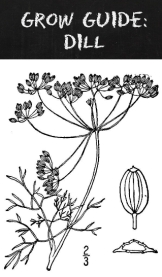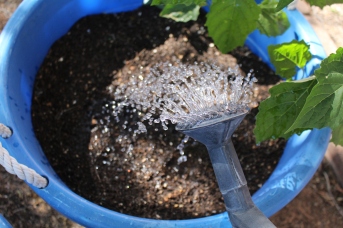
Summary:
Sow mid just before last frost, or in mid-October in zone 9A.
Soil: 1/2 sand & 1/2 potting mix or compost
Bury seeds 1/4-1/2 inch deep (1/2 cm)
Water every 3-4 days
Harvest and make pickles or freeze for use over winter.
Warning: If soil is more than 1/2 potting mix, or if you bury them too deep, seeds may not sprout.
Dill is a beautiful plant with SO many uses. If you’re into pickles, you’ll want those big heads (what I’m after), maybe the fully formed seeds themselves, and a those stems! They hold more flavor than you would expect! Chopped leaves go beautifully with salads, dressings, and best of all, on baked potatoes. Here’s how you can start enjoying this amazing herb.
Dill can be planted just after the last spring frost, or here in the desert southwest, in mid-October. Plants have a single tap-root that needs plenty of depth. If you are growing them in a container, it should be at least 24 inches deep. Don’t bother starting them inside either, dill is a fussy transplant candidate.
There are two ways to plant dill seeds. Soil should be half sand, and half potting mix or compost. Moist soil is best for this method.  Plant 3-4 seeds in a single hole, 1/4-1/2 inch deep (1/2 cm works), and 12 inches apart. Moist soil is best for this method. I like to use an old ruler that I won’t mind getting dirty. Put your thumb at the appropriate mark and insert until your finger hits the top of the soil, rocking back and forth to create a divot. Insert your seeds and tap them down with the ruler if you feel they still aren’t resting at the correct depth. Pinch the soil to cover, don’t compress the soil on top of them. Be sure to pay attention because if you plant them too deep they may not sprout.
Plant 3-4 seeds in a single hole, 1/4-1/2 inch deep (1/2 cm works), and 12 inches apart. Moist soil is best for this method. I like to use an old ruler that I won’t mind getting dirty. Put your thumb at the appropriate mark and insert until your finger hits the top of the soil, rocking back and forth to create a divot. Insert your seeds and tap them down with the ruler if you feel they still aren’t resting at the correct depth. Pinch the soil to cover, don’t compress the soil on top of them. Be sure to pay attention because if you plant them too deep they may not sprout.
 Water every 3 to 4 days. But keep a close watch, check moisture every day. Again, thin seedlings until there is one foot between plants. Once the seeds have a good amount of growth on them be sure to mulch around the base with more compost, then wood chips or straw on top of that to keep in moisture. Plants will bolt quickly in warm weather, so keep an eye on them and cut what you need as it grows!
Water every 3 to 4 days. But keep a close watch, check moisture every day. Again, thin seedlings until there is one foot between plants. Once the seeds have a good amount of growth on them be sure to mulch around the base with more compost, then wood chips or straw on top of that to keep in moisture. Plants will bolt quickly in warm weather, so keep an eye on them and cut what you need as it grows!
Did you know? Parents would give their children dill heads to chew on in church to keep them occupied. Saving seeds is also a good plan!
Pro tip: Large heads of dill freeze well, and if you are using them for pickles, some say the flavor is better after freezing. Cut and freeze them in a bag, and as they grow, this should lead to more flowering and more production.
It’s as simple as that. Finding a variety that’s been grown in your area for a while will enhance your growing success. But trusting the experts at your favorite seed company will also do just fine.